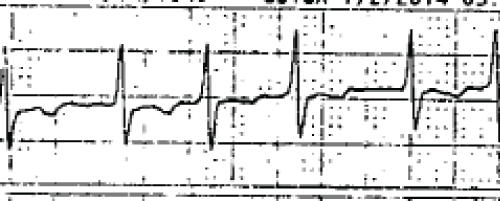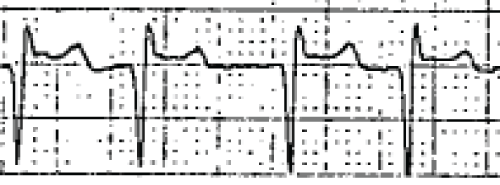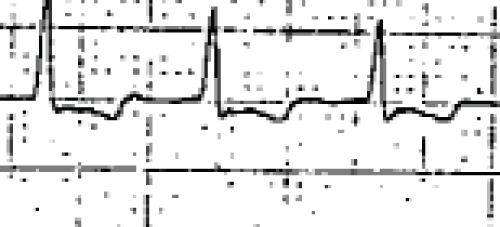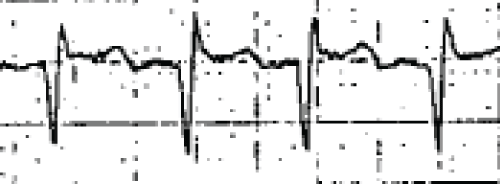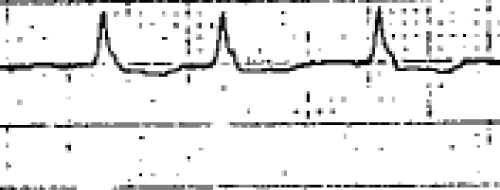International Journal of Clinical Cardiology
An Unlikely cause of Atrial Fibrillation-induced Cardiomyopathy: Phentermine, a diet pill
Sunny-Skye Keppel1 and Philip Varriale2*
1Department of Medicine, Mount Sinai Beth Israel, USA
2Department of Cardiology, Mount Sinai Beth Israel, USA
*Corresponding author: Philip Varriale, Department of Cardiology, Mount Sinai Beth Israel, New York, NY, USA, Tel: (212) 777-3219, E-mail: pvarriale@chpnet.org
Int J Clin Cardiol, IJCC-2-029, (Volume 2, Issue 2), Case Report; ISSN: 2378-2951
Received: March 16, 2015 | Accepted: April 15, 2015 | Published: April 19, 2015
Citation: Keppel SS, Varriale P (2015) An Unlikely cause of Atrial Fibrillation-induced Cardiomyopathy: Phentermine, a diet pill. Int J Clin Cardiol 2:029. 10.23937/2378-2951/1410029
Copyright: © 2015 Keppel SS, et al. This is an open-access article distributed under the terms of the Creative Commons Attribution License, which permits unrestricted use, distribution, and reproduction in any medium, provided the original author and source are credited.
Abstract
We present a case of an unusual cause of atrial fibrillation-induced cardiomyopathy, which is a diet pill, known as phentermine. This medication used for weight loss and can function as a stimulant is intended for short-term use but when taken for an extensive period of time can become a significant risk factor for developing arrhythmias such as atrial fibrillation.
Keywords
Atrial fibrillation, Cardiomyopathy, Phentermine
Introduction
Most of the causes of atrial fibrillation are due to intrinsic disorders such as high blood pressure, coronary artery disease, abnormal heart valves, thyroid dysfunction [1], to name a few, however medications should also be considered high in the differential of new diagnosis of atrial fibrillation. In this case, a diet pill, phentermine was the underlying cause of atrial fibrillation- induced cardiomyopathy.
Case Description
A 65 year-old man with past medical history of insomnia presented to Mount Sinai Beth Israel with palpitations, dyspnea and orthopnea. He also reported a 30-pound weight gain over the past several months. He initially went to his primary care doctor that morning with those symptoms, and a twelve-lead electrocardiogram was performed and was consistent with atrial fibrillation with rapid ventricular response to 180 beats per minute, so he was referred to Mount Sinai Beth Israel Hospital immediately for further evaluation. He denied any other constitutional symptoms such as chest pain, fevers, chills, nausea, vomiting or abdominal pain. He reported that he takes two medications, which include lorazepam as needed for anxiety and propecia for male pattern baldness. He denied any toxic habits.
In the Emergency Department, a twelve-lead electrocardiogram was done and was consistent with atrial fibrillation with rapid ventricular response to 180 beats per minute (Figure 1). In the Emergency Department, he was started on heparin drip 12 units/kg/hr, received total diltiazem 40mg IV push and diltiazem 30mg PO, aspirin 325mg PO and metoprolol 25mg PO. However, his heart rate continued to remain in the 140s bpm, so the patient was admitted to medicine service/telemetry unit.
Physical exam was notable for a caucasian, overweight man, with irregularly irregular rhythm, loud S3 gallop, and 3+ bilateral lower extremity edema with distal petechiae. Initial laboratory studies were notable for elevated D-Dimer of 3.53ug/ml, troponins negative of 0.019ng/ml and 0.024ng/ml, elevated creatinine of 1.46mg/dl, normal TSH of 0.54mIU/ml, BNP of 427pg/ml and AST/ALT of 60U/L and 87U/L respectively. Repeat electrocardiogram showed atrial fibrillation at 130 beats per minute and left ventricular hypertrophy with abnormal repolarization. Chest x-ray was consistent with cardiomegaly. Transthoracic echocardiogram was consistent with global hypokinesia, with ejection fraction of 15%, congestive heart failure with bi-ventricular decompensation. In addition, he had lower extremity sonogram done which showed no evidence of acute deep venous thrombosis. Due to the patientís persistent dyspnea and new diagnosis of decompensated congestive heart failure, with unknown cause, left heart catherization was performed. It showed mild non-obstructive coronary artery disease; the left main artery had mild diffuse disease, left circumflex and left anterior descending arteries both with mild diffuse disease in proximal portion with 50% stenosis in mid-portion and mild diffuse disease in distal portion, also there was mild diffuse disease of the right coronary artery.
At this point, the leading diagnosis was cardiomyopathy secondary to possible myocarditis. Therefore, further laboratory testing was done to evaluate for infectious and/or rheumatologic causes. CRP was elevated at 11.0mg/L, CMV IgM negative, CMV by PCR was negative, EBV negative, HIV nonreactive, Coxsackie A and B negative, Hepatitis B surface antigen negative and Hepatitis B surface antibody reactive, Hepatitis C antibody negative and Lyme disease antibody negative.
During the hospital course the patient received rate control with oral metoprolol 100mg every eight hours, diuresis with a loop diuretic, torsemide was used and anticoagulation with apixaban. His heart rate was resistant to therapeutic doses of metoprolol, it remained as high as 130s-150s bpm, so he had to be titrated up to as high as receiving total of 400mg metoprolol daily (Figures 2-6). However, his blood pressure from initial admission was well controlled, with ranges from 105-127/73-100mmHg during the hospitalization. The patient did not have elevated blood pressure during hospitalization, nor did he have diagnosis of hypertension, as he followed up annually with his primary care doctor. It was still unclear why this patient developed acute heart failure without any known past medical history and unremarkable laboratory workup. The next step was to re-interview the patient to obtain more detailed history. The patient eventually informed the medical team that besides taking lorazepam and propecia as he mentioned before in his medication reconciliation, he had been taking a diet pill known as Phentermine also known as Adipex-P, Obenix or Suprenza [2] for the past 3 years, 3-5 days per week, for the purpose of weight loss. He stated that this medication acted as an appetite suppressant and even as a stimulant. Finally, it was determined that this diet pill was most likely the precipitant of his tachycardia-induced cardiomyopathy, or drug toxic cardiomyopathy.
The patient was informed of the risks of this medication and after further research, it was determined that this medication is not approved for long-term treatment. Extensive discussion about the risks of this medication was discussed with the patient and he verbalized understanding. His symptoms were much improved prior to discharge and he had no signs or symptoms of heart failure. He was discharged on apixaban and metoprolol. He was discharged with outpatient follow-up with the cardiologist who followed him while he was an inpatient. However, one month later the patient was sent to Mount Sinai Beth Israel Hospital by his cardiologist, due to persistent atrial fibrillation and rapid ventricular rate to 130bpm for electrical cardioversion. The electrical cardioversion was successful.
Repeat electrocardiogram showed sinus rhythm at 68bpm, QTc 463 msec and PR interval 168 msec. Repeat transthoracic echocardiogram was consistent with ejection fraction of 35%, normal left ventricular size, diffuse left ventricular hypokinesis, mild to moderately reduced left ventricular systolic function, left ventricular hypertrophy and biatrial dilatation. He was then discharged on apixaban 5mg twice a day, amiodarone 200mg twice a day, metoprolol tartrate 50mg twice a day, atorvastatin 10mg daily and lisinopril 2.5 mg daily.
Discussion
We present a case in which common symptoms of palpitations, dyspnea and orthopnea found to be due to atrial fibrillation are due to an uncommon cause, a diet pill. In this case, his acute decompensated heart failure with left and right ventricular systolic dysfunction due to atrial fibrillation with ultra-rapid ventricular response was likely stimulated by the medication, phentermine. Of note, this patient also has underlying risk factors for developing atrial fibrillation, which include being male and obese, however phentermine likely was a major contributor to this event. Phentermine is a psychostimulant drug of the phenethylamine class with pharmacology similar to an amphetamine, which is used as an appetite suppressant [2]. His resistant rapid heart rate was likely mediated by the adrenergic drive of phentermine. Despite short-term control of his heart rate in the Emergency Department from 180bpm to 130bpm, his heart rate fluctuated from 120s-170s during the hospital course (Figures 2-6). His long-term phentermine use opposed the effectiveness of therapeutic doses of B-blockers.
Phentermine is an atypical amphetamine analogue that works by increasing norepinephrine in the central nervous system which suppresses appetite [2]. Phentermine hydrochloride is approved in the United States for short term, up to 12 weeks treatment of obesity along with dietary and lifestyle modifications, including exercise, behavioral modification and caloric restriction for patients with an initial BMI of ≥30kg/m2 or ≥27kg/m2 in the presence of risk factors such as hypertension, diabetes and hyperlipidemia [2]. Contraindications to using phentermine include: history of coronary artery disease, stroke, arrhythmias, congestive heart failure and uncontrolled hypertension [2]. However, this patient had been using phentermine for 3 years [3]. Phentermineís action peaks from 3.0 to 4.4 hours and is primarily excreted in the urine [3]. Phentermine used as a monotherapy in several studies for up to 36 weeks have demonstrated reductions in body weight and waist circumference with at least 5 or 10% weight loss as compared to placebo [2]. Some known adverse effects of phentermine include primary pulmonary hypertension and valvular disease [2]. In fact, the largest study to demonstrate a relation between the length of treatment with fenfluramine-phentermine and prevalence of valvular abnormalities was published in Circulation journal by Jollis et al. [3]. It showed that among 1163 patients who had taken fenfluramine-phentermine within 5 years of enrollment and 672 control patients who had not taken the drug combination, mild or greater aortic regurgitation was present in 8.8% of treated patients and 3.6% of control patients (p< 0.001) [3]. Overall the findings suggested that valvular abnormalities in patients who took fenfluramine-phentermine are present when these medications are taken for over 6 months, and the predominant finding is mild aortic regurgitation [3]. However, atrial fibrillation has not been well described to be an adverse effect of this medication.
Also important to discuss is this patientís other underlying risk factors such as obesity. In a study published in American Heart Journal by Wanahita et al. based on population-based cohort studies, obese individuals have an 49% increased risk of developing atrial fibrillation compared to nonobese individuals (relative risk 1.49, 95% CI 1.36-1.64) [4]. Therefore, obesity likely played a major role in causing the atrial fibrillation. Even though the clear sequence of sinus rhythm prior to phentermine use cannot be confirmed, it is notable that this patient followed up regularly with his primary care doctor and did not have any history of arrhythmias.
Conclusion
This case emphasizes the importance of having a detailed and comprehensive history, which often gives much insight as to what the underlying diagnosis is. In addition, it shows that when diagnosing atrial fibrillation it is essential to rule out causes due to medications as well and to obtain a complete medication list, as often the cause can be extrinsic.
References
-
Falk RH (2001) Atrial fibrillation. N Engl J Med 344: 1067-1078.
-
Jordan J, Astrup A, Engeli S, Narkiewicz K, Day WW, et al. (2014) Cardiovascular effects of phentermine and topiramate: a new drug combination for the treatment of obesity. J Hypertens 32: 1178-1188.
-
Jollis J, Landolfo C, Kisslo J, Constantine G, Davis K, et al. (2000) Fenfluramine and Phentermine and Cardiovascular Findings Effect of Treatment Duration on Prevalence of Valve Abnormalities. Circulation 101: 2071-2077.
-
Wanahita N, Messerli FH, Bangalore S, Gami AS, Somers VK, et al. (2008) Atrial fibrillation and obesity--results of a meta-analysis. Am Heart J 155: 310-315.






